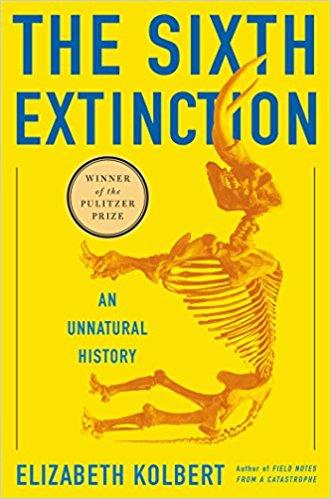The Sixth Extinction Summary
3 min read ⌚
 An Unnatural History
An Unnatural History
“The Sixth Extinction” provides a look at the history of the planet, followed by a distressing prediction of the future.
About Elizabeth Kolbert
 Elizabeth Kolbert is a book author and a New Yorker staff writer.
Elizabeth Kolbert is a book author and a New Yorker staff writer.
“The Sixth Extinction PDF Summary”
66 million years ago, an asteroid hit Earth and wiped out dinosaurs, mammals, marine life, various birds, and plants.
Author Elizabeth Kolbert reports that this incident was the fifth time in 500 million years that natural events nearly killed all life on Earth.
In fact, Earth’s history is marked by long spans of incremental change, and moments of catastrophic transformation, or as paleontologist David Raup says: “long periods of boredom occasionally interrupted by panic.”
The planet is now in the phase of “The Sixth Extinction,” but according to Kolbert, this time it will not be the nature that will destroy life.
Instead, humans will be to blame.
We all know that the transformation of the nature that humans enable, covering the ground with roads, cities, and farms, and destroying forests, is the reason why we are encountering the consequences of the global warming and similar ecological concerns.
A large number of birds, mammals, amphibians, and reptiles are on the verge of extinction, as people’s activities fill the waters and atmosphere with unheard-of levels of carbon dioxide.
By harming the ecosystems that are the foundation of life, people endanger themselves.
And indeed, it is not just animals and plants that suffer – people suffer as well: various forms of diseases appear out of thin air, shortening people’s lives.
Environmental change fuels both evolution and extinction.
Elizabeth Kolbert does not try to veil her distressing content into sugary covers.
She serves the truth raw, occasionally leavens the dark topics she writes about with illuminating stories and a dosage of humor.
“The Sixth Extinction” is a terrifically written warning of what humanity may do to its own habitat, that everyone should read.
Key Lessons from “The Sixth Extinction”
1. The Sources of Extinction
2. Gradual and Extreme Changes
3. The Three Main Mechanisms by Which Humankind is Changing the Planet
The Sources of Extinction
For years scientists believed that all mass extinctions happened because of asteroid hits.
However, after studying rock samples, they realized that this was not the case.
Each of the “Big Five” extinctions happened after a unique set of conditions existed in the environment.
Gradual and Extreme Changes
Following the standard gradual course of evolution, when the environment changes, organisms have the time to adapt to these transformations.
When the changes are extreme and are moving fast, on the other hand, organisms do not have the time to adapt which leads to their extinction.
The Three Main Mechanisms by Which Humankind is Changing the Planet
-
- Carbon Dioxide: 365 billion metric tons of carbon have been released into the air since the Industrial Revolution, all by burning fossil fuels. Cutting down trees increases this number by 180 billion tons.
-
- Species Dispersion: people have dispersed different species into geographical locations which they could not reach otherwise.
- “Islands on Dry Land”: humankind remodels the surface of Earth, sometimes to a dangerous extent.
Like this summary? We’d Like to invite you to download our free 12 min app, for more amazing summaries and audiobooks.
“The Sixth Extinction Quotes”
Though it might be nice to imagine there once was a time when man lived in harmony with nature, it’s not clear that he ever really did. Share on X A sign in the Hall of Biodiversity offers a quote from the Stanford ecologist Paul Ehrlich: IN PUSHING OTHER SPECIES TO EXTINCTION, HUMANITY IS BUSY SAWING OFF THE LIMB ON WHICH IT PERCHES. Share on X Somewhere in our DNA must lie the key mutation (or, more probably, mutations) that set us apart—the mutations that make us the sort of creature that could wipe out its nearest relative, then dig up its bones and reassemble its genome. Share on X The current extinction has its own novel cause: not an asteroid or a massive volcanic eruption but one weedy species. Share on X By burning through coal and oil deposits, humans are putting carbon back into the air that has been sequestered for tens—in most cases hundreds—of millions of years. In the process, we are running geologic history not only in reverse but… Share on X
Emir is the Head of Marketing at 12min. In his spare time, he loves to meditate and play soccer.


 An Unnatural History
An Unnatural History



